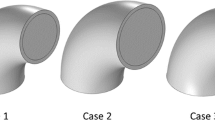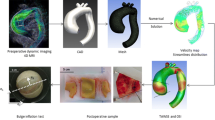Abstract
Marfan syndrome (MFS) is a genetic disorder that affects connective tissue, impairing cardiovascular structures and function, such as heart valves and aorta. Thus, patients with Marfan disease have a higher risk of developing circulatory problems associated with mitral and aortic valves prolapse, manifested as dilated aorta and aortic aneurysm. However, little is known about the biomechanical characteristics of these structures affected with MFS. This study presents the modelling and simulation of the mechanical response of human ascending aortic aneurysms in MFS under in vivo conditions with intraluminal pressures within normotensive and hypertensive ranges. We obtained ascending aortic segments from five adults with MFS subjected to a vascular prosthesis implantation replacing an aortic aneurysm. We characterised the arterial samples via ex vivo tensile test measurements that enable fitting the material parameters of a hyperelastic isotropic constitutive model. Then, these material parameters were used in a numerical simulation of an ascending aortic aneurysm subjected to in vivo normotensive and hypertensive conditions. In addition, we assessed different constraints related to the movement of the aortic root. Overall, our results provide not only a realistic description of the mechanical behaviour of the vessel, but also useful data about stress/stretch-based criteria to predict vascular rupture. This knowledge may be included in the clinical assessment to determine risk and indicate surgical intervention.






Similar content being viewed by others
References
Alhayani AA, Giraldo JA, Rodrguez J, Merodio J (2013) Computational modelling of bulging of inflated cylindrical shells applicable to aneurysm formation and propagation in arterial wall tissue. Finite Elem Anal Des 73:20–29
Alhayani AA, Rodrguez J, Merodio J (2014) Competition between radial expansion and axial propagation in bulging of inflated cylinders with application to aneurysms propagation in arterial wall tissue. Int J Eng Sci 85:74–89
Azadani AN, Chitsaz S, Mannion A, Mookhoek A, Wisneski A, Guccione JM, Hope MD, Ge L, Tseng EE (2013) Biomechanical properties of human ascending thoracic aortic aneurysms. Ann Thorac Surg 96:50–58
Beller CJ, Labrosse MR, Thubrikar MJ, Robicsek F (2004) Role of aortic root motion in the pathogenesis of aortic dissection. Circulation 109:763–769
Beller CJ, Labrosse MR, Thubrikar MJ, Szabo G, Robicsek F, Hagl S (2005) Increased aortic wall stress in aortic insufficiency: clinical data and computer model. Eur J Cardio-thorac Surg 27:270–275
Demiray H (1972) On the elasticity of soft biological tissues. J Biomech 5:309–311
Di Martino ES, Vorp DA (2003) Effect of variation in intraluminal thrombus constitutive properties on abdominal aortic aneurysm wall stress. Ann Biomed Eng 31:804–809
Doyle BJ, Cloonan AJ, Walsh MT, Vorp DA, McGloughlin TM (2010) Identification of rupture locations in patient-specific abdominal aortic aneurysms using experimental and computational techniques. J Biomech 43:1408–1416
Doyle BJ, Killion J, Callanan A (2012) Use of the photoelastic method and finite element analysis in the assessment of wall strain in abdominal aortic aneurysm models. J Biomech 45:1759–1768
Duprey A, Khanafer K, Schlicht M, Avril S, Williams D, Berguer R (2010) In vitro characterization of physiological and maximum elastic modulus of ascending thoracic aortic aneurysms using uniaxial tensile testing. Eur J Vasc Endovasc Surg 39:700–707
Erbel R, Eggebrecht H (2006) Aortic dimensions and the risk of dissection. Heart 92:137–142
Ergin MA, Spielvogel D, Apaydin A, Lansman SL, McCullough JN, Galla JD, Griepp RD (1999) Surgical treatment of the dilated ascending aorta: when and how? Ann Thorac Surg 67:1834–1839
Ferrara A, Morganti S, Totaro P, Mazzola A, Auricchio F (2016) Human dilated ascending aorta: mechanical characterization via uniaxial tensile tests. J Mech Behav Biomed Mater 53:257–271
García-Herrera CM (2008) Mechanical behaviour of the human ascending aorta: characterization and numerical simulation. Ph.D. thesis (in Spanish), Universidad Politécnica de Madrid
García-Herrera CM, Atienza JM, Rojo F, Claes E, Guinea GV, Celentano D, García-Montero C, Burgos R (2012a) Mechanical behaviour and rupture of normal and pathological human ascending aortic wall. Med Biol Eng Comput 50(6):559–566
García-Herrera CM, Celentano DJ, Cruchaga MA, Rojo FJ, Atienza JM, Guinea GV, Goicolea JM (2012b) Mechanical characterisation of the human thoracic descending aorta: experiments and modelling. Comput Methods Biomech Biomed Eng 15:185–193
García-Herrera CM, Celentano DJ (2013) Modelling and numerical simulation of the human aortic arch under in vivo conditions. Biomech Model Mechanobiol 12:1143–1154
Grande-Allen KJ, Cochran RP, Reinhall PG, Kunzelman KS (2001) Mechanisms of aortic valve incompetence: finite-element modeling of Marfan syndrome. J Thorac Cardiovasc Surg 122(5):946–954
Iliopoulos D, Deveja RP, Kritharis EP, Perrea D, Sionis GD, Toutouzas K, Stefanadis C, Sokolis D (2009) Regional and directional variations in the mechanical properties of ascending thoracic aortic aneurysms. Med Eng Phys 31:1–9
Koullias G, Modak R, Tranquilli M (2005) Mechanical deterioration underlies malignant behavior of aneurysmal human ascending aorta. J Thorac Cardiovasc Surg 130:677.e1–677.e9
Laurent S, Cockcroft J, Bortel LV, Boutouyrie P, Giannattasio C, Hayoz D, Pannier B, Vlachopoulos C, Wilkinson I, Struijker-Boudier H (2006) Expert consensus document on arterial stiffness: methodological issued and clinical applications. Eur Heart J 27:2588–2605
Li Z, Kleinstreuer C (2005) A new wall stress equation for aneurysm-rupture prediction. Ann Biomed Eng 33:209–213
Martufi G, Gasser TC, Appoo JJ, Di Martino ES (2014) Mechano-biology in the thoracic aortic aneurysm: a review and case study. Biomech Model Mechanobiol 13:917–928
Medina E, Kaempffer A (2007) Enfermedades Cardiovasculares en Chile: Aspectos Epidemiológicos. Rev Chil Cardiol 26:219–226
Meijboom L, Vos F, Timmermans J, Boers G, Zwinderman A, Mulder B (2005) Pregnancy and aortic root growth in the Marfan syndrome: a prospective study. Eur Heart J 26:914–920
Merodio J, Haughton D (2010) Bifurcation of thick-walled cylindrical shells and the mechanical response of arterial tissue affected by Marfan’s syndrome. Mech Res Commun 38:1–6
Nakagiri K, Kadowaki T, Morimoto N, Murakami H, Yoshida M, Mukohara N (2012) Aortic root reimplantation for isolated sinus of Valsalva aneurysm in the patient with Marfan’s syndrome. Ann Thorac Surg 93:E49–E51
Nathan DP (2011) Pathogenesis of acute aortic dissection: a finite element stress analysis. Ann Thorac Surg 91:458–463
Nichols W, Rourke MO (1990) McDonald’s flow in arteries theoretical, experimental and clinical principles, 3rd edn. Oxford University, New York
Nollen GJ, Groenink M, Tijssen JGP, van der Wall EE, Mulder BJM (2004) Aortic stiffness and diameter predict progressive aortic dilatation in pacients with Marfan syndrome. Eur Heart J 25:1146–1152
Okamoto RJ, Wagenseil JE, DeLong WR, Peterson SJ, Kouchoukos NT, Sundt TM III (2002) Mechanical properties of dilated human ascending aorta. Ann Biomed Eng 30:624–635
Pape LA, Tsai TT, Isselbacher EM, Oh JK, O’gara PT, Evangelista A, Fattori R, Meinhardt G, Trimarchi S, Bossone E, Suzuki T, Cooper JV, Froehlich JB, Nienaber CA, Eagle KA (2007) Aortic diameter > or \(= 5.5\) cm is not a good predictor of type a aortic dissection. Observations from the International Registry of Acute Aortic Dissection (IRAD). Circulation 116(10):1120–1127
Pasta S, Phillippi JA, Gleason TG, Vorp DA (2012) Effect of aneurysm on the mechanical dissection properties of the human ascending thoracic aorta. J Thorac Cardiovasc Surg 143:460–467
Pasta S, Rinaudo A, Luca A, Pilato M, Scardulla C, Gleason TG, Vorp DA (2013) Difference in hemodynamic and wall stress of ascending thoracic aortic aneurysms with bicuspid and tricuspid aortic valve. J Biomech 46:1729–1738
Phillippi JA, Pasta S, Vorp DA (2011) Biomechanics and pathobiology of aortic aneurysms. Stud Mechanobiol Tissue Eng Biomater 7:67–118
Pichamuthu JE, Phillippi JA, Cleary DA, Chew DW, Hempel J, Vorp DA, Gleason TG (2013) Differential tensile strength and collagen composition in ascending aortic aneurysms by aortic valve phenotype. Ann Thorac Surg 96(6):2147–2154
Pruzinsky MS, Katz NM, Green CE, Satler LF (1988) Isolated descending thoracic aortic aneurysm in Marfan’s syndrome. Am J Cardiol 61:1159–1160
Putz R, Pabst R, Weiglein A (2001) Sobotta atlas of human anatomic atlas, vol 2. Lippincott Williams & Wilkins, Philadelphia
Rose JL, Lalande A, Bouchot O, Bourennane EB, Walker PM, Ugolini P, Revol-Muller C, Cartier R, Brunotte F (2010) Influence of age and sex on aortic distensibility assessed by MRI in healthy subjets. Magn Reson Imaging 28:255–263
Vande Geest JP, Schmidt DE, Sacks MS, Vorp DA (2008) The effects of anisotropy on the stress analyses of patient-specific abdominal aortic aneurysms. Ann Biomed Eng 36:921–932
Vorp DA (2007) Biomechanics of abdominal aortic aneurysm. J Biomech 40:1887–1902
Vorp DA, Vande Geest JP (2005) Biomechanical determinants of abdominal aortic aneurysm rupture. Arterioscler Thromb Vasc Biol 25:1558–1566
Acknowledgments
The supports provided by DICYT Project 051415GH of the Universidad de Santiago de Chile (USACH) and FONDECYT Grant No. 1151119 of the Chilean Council for Research and Technology (CONICYT) are gratefully acknowledged.
Author information
Authors and Affiliations
Corresponding author
Ethics declarations
Conflict of interest
The authors declare no conflicts of interest.
Rights and permissions
About this article
Cite this article
García–Herrera, C.M., Celentano, D.J. & Herrera, E.A. Modelling and numerical simulation of the in vivo mechanical response of the ascending aortic aneurysm in Marfan syndrome. Med Biol Eng Comput 55, 419–428 (2017). https://doi.org/10.1007/s11517-016-1524-7
Received:
Accepted:
Published:
Issue Date:
DOI: https://doi.org/10.1007/s11517-016-1524-7




